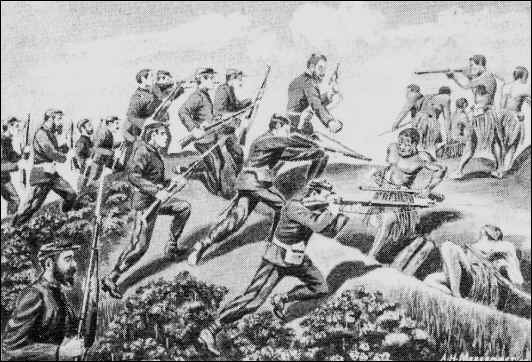Maori warriors were fierce, who fought bravely and with honor. With their guerrilla tactics and their typical close-combat,
carved weapons they were masters in surprise attacks/ambushing.
Their territories have never been conquered by other nations. There were many battles and wars about honor, land, and possessions among Maori tribes. These tribal wars were fought in the summer between November and April.
It was an ultimate goal to defeat the strongest enemy of the opposing tribe because this would result in the most mana for the warrior and his tribe. When the Europeans later settled New Zealand, they fought just as passionately against the intruders.
Before the Europeans set foot in New Zealand warfare between Maori tribes was commonplace. From a young age male members of Maori tribes were educated in warfare and combat tactics. Later on the British troops personally experienced how fierce and powerful these experts in guerrilla warfare were.
Defensive and Offensive Tactics
The Maori built war canoes from large indigenous trees. These massive war canoes had a capacity of 70 people and measured 70 feet in length. These war canoes were chiefly used to carry troops down the rivers or along the coast to move swiftly and silently towards their enemies. The Maori deeply valued surprise as their primary war tactic. War parties would ambush their enemies, using feint attacks and try to catch them unprepared for battle.
Maori Fortresses
The Maori built great fortresses to defend their people from neighboring tribes. These fortresses were large and usually placed in good lookout spots, such as on top of a hill. Sentries were posted along the fortress walls to look out for the enemy. These sentries sang and banged on a gong when no enemy was near but became silent when they spotted someone. Then Hapus of 140 – 340 warriors were dispatched and hid to ambush the enemy.
Weapons
The Maori fought their battles with long spears and both long and short clubs. The spears were thrust at their enemies with sharpened ends. These wicked spears were 6 to 9 feet long keeping some defensive distance between the soldier and his enemy. This defensive distance was important because the Maori did not use shields and only kept a short club for close combat.
This short club was made of wood, bone or stone and had a flat blade attached to it. Long clubs were also kept. These weapons were about 5 feet long and had both a bladed end and pointed end for striking and stabbing the enemy.
Haka
The haka, preceding the battle was performed to boost patriotism and morale among their people as well as to fear the enemy. The haka is characterized by chanting, singing, defiant movements, sounds, rolling with the eyes, and a protruding tongue and was an essential part of Maori warfare.
Training and Rituals
Maori children were taught constant vigilance, agility and strength their entire lives to remain ever ready for war.
The Maori people also engaged in cannibalism. They saw the flesh of their fallen enemies as spiritually given food rations to keep up their strength war. However, they rarely engaged in cannibalism during peacetime. Lasting peace was achieved through the intermarriage of tribe leaders. Once two tribes were kinsman, they no longer believed it was honorable to war between each other.
Mana, Spiritual Power
Maori warriors with a considerable amount of mana possessed power and authority. When they triumphed in battle they gained extra mana which would eventually be passed on via the weapons to next generations. In this way these carved weapons were imbued with the sacred power of their predecessors and gained authority over time. Defeated warriors believed that they must defeat their enemies to restore their
mana or sacred energy, so war was a vicious cycle.
Religious influence
The ancient Maori had two primary gods: Tu, the war god and Rongo, the god of peace and agriculture. During the planting season the Maori people were primarily peaceful in order to plant harvest their crops. A good harvest was essential to prevent starvation, and that was seen as more important than war.
Once their food for the year was stockpiled, Maori tribes waged war on once another in the name of Tu, the vengeful war god. Like the small Greek city states, the Maori people could fight ferociously together as a tribe but had trouble unifying all tribes together.
